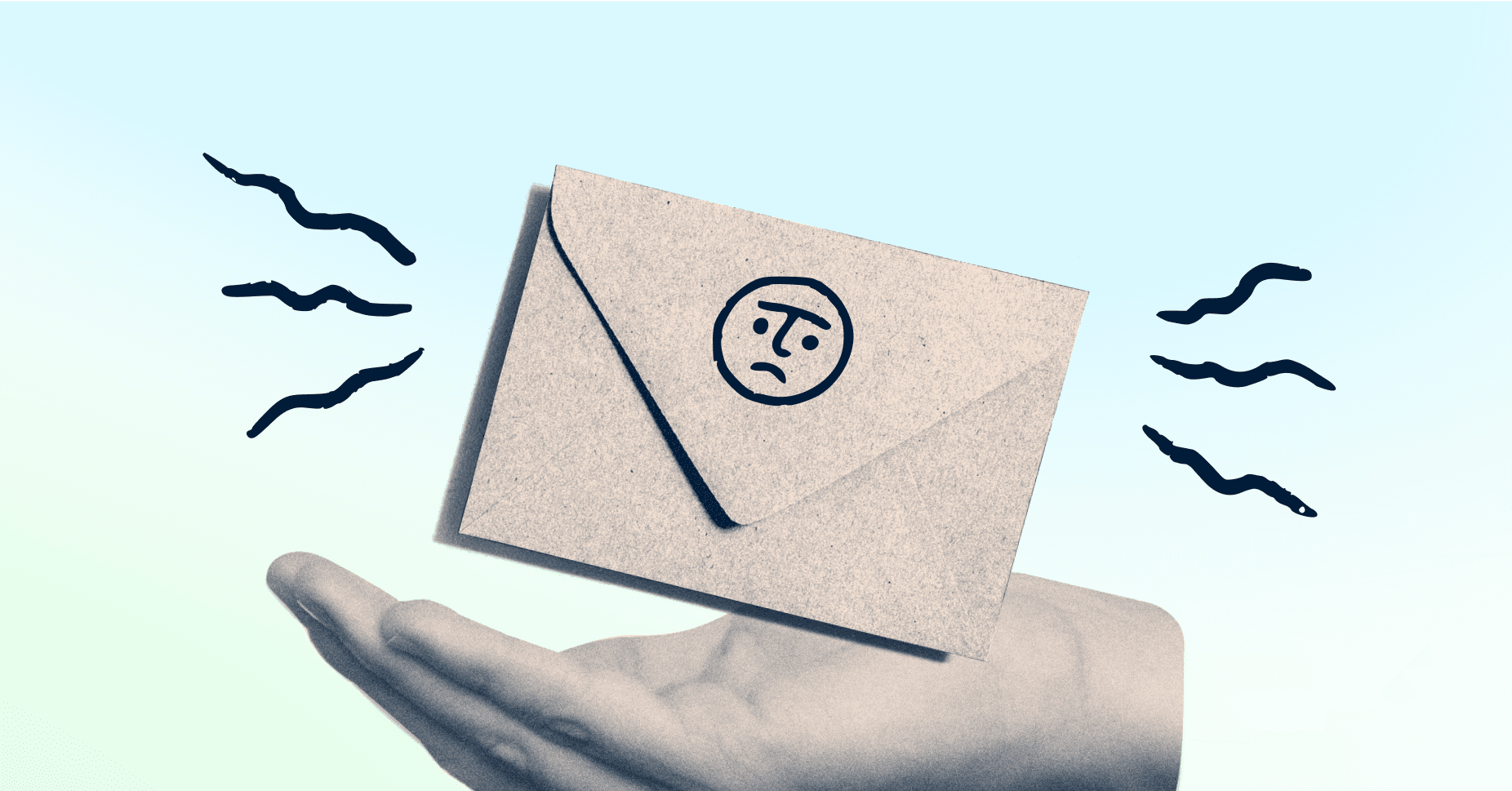Whether it’s a scheduling mishap, a bug in your product, or something more serious like an app outage or security breach, communicating about mistakes with customers certainly isn’t easy. The good news? Sending an apology email is your chance to start a healthy conversation and potentially build a stronger relationship with your customers.
Crafting a message that strikes the right tone for your apology can certainly be an art — and we can learn a lot from seeing how others do it. We collected a few real examples from customer success managers and company leaders. They contain great copy for admitting your mistakes, apologizing, and setting customers up for future success.
When you’re sending an apology as a reply:
1. We were wrong. Here’s what happened.
Hi {Customer name},
Thanks for being patient while we sort this out. After an in-depth discussion with my team, we’ve realized that we’re responsible for these issues. Given the progress we’ve made in the last {weeks/months/years}, our relationship is extremely important to us, and we never want our errors to set you off track. We want to make sure you’re back on track for meeting your goals ASAP.
We’re very committed to making it right, so here’s our plan for moving forward: {insert plans here}.
Thank you for your patience and understanding,
{Name}
When to use this apology email:
Your client will see you as more credible and trustworthy if you give them every detail of what happened and why. If something was truly your fault, avoid using language that blurs the lines or shoves off the blame, like “we’re sorry this happened to you.” Instead, send this to take full responsibility for the problem.
2. We’re working on it.
Hi {Customer name},
I’m sorry about {insert problem here}. I’m talking with my team about exploring this issue more now. I just want to let you know that your issue is important to us, and we’ll get back to you ASAP with proper insight and solutions.
Thanks for your patience,
{Name}
When to use this apology email:
Giving a swift reply explaining that a customer’s issue is a top priority can make a huge difference in showing them you care. Send something like this when you’re still working on finding a resolution and digging into a problem.
3. Still not sure…help us understand the problem further.
Hi {Customer name},
Thanks for reaching out to us about {insert issue here}. We’ve spent the last few days assessing what’s been going on, and we really appreciate your patience during this time. Although we’ve been working on resolutions, we still haven’t found a fix. Here’s what we’ve tried so far:
{list what you’ve tried}
I am very committed to fixing this for you. I’d really like to hear more about your experience so that we can make sure we’re on the same page and figure out next steps. To start, I have some questions:{insert questions}
Thanks again for your patience while we work through this. I’m confident we’ll find a resolution soon.
Sincerely,
{Name}
When to use this apology email:
This message is for that time when you’ve been working on fixing a problem for a while, and you still can’t figure it out. The best course of action? Be transparent about it. Make a bulleted list of the things you tried, and follow with a list of questions. This email should be straight to the point, but keep an optimistic attitude.
In the instances above, you’re replying when a customer comes to you with a problem. But that’s not always the case. What about when you’re initiating the conversation?
When you’re initiating the apology:
1. Important security notice
Dear {Customer name},
We are writing to inform you that we were recently able to confirm that there was unauthorized access to a {company} database containing user profile information. We have since blocked this unauthorized access and made additional changes to our technical infrastructure to prevent future incidents. We have made all relevant details available on our blog. No specific action is required of you.
However, we have also just released Two Factor Authentication (“2FA”; also known as “two step verification”) and we strongly recommend that all users enable this feature, which provides an additional layer of security for their account. Additional details are available in our help center and you can enable 2FA directly on your account settings page.
Since the compromised system was first discovered, we have been working 24 hours a day to methodically examine, rebuild and test each component of our system to ensure it is safe. We are very aware that our service is essential to many teams. Earning your trust through the operation of a secure service will always be our highest priority. We deeply regret this incident and apologize to you, and to everyone who relies on us, for this inconvenience.
For more on our security practices and policies, see {link}. Again, for additional information, we encourage you to read the blog post for more details.
Sincerely,
{Your name}
What makes this apology email great:
The tone of this apology is serious, but optimistic. It starts with a detailed, honest assessment of the problem and a recommendation to help fix it. Next they explain their fault, commitment to a resolution, a sincere apology, and resources for finding more information.
2. Outage
Hello {Customer name},
I’m emailing to update you on our service outages on {time and day}. Service was fully restored at about {time}.
I know this has been a very frustrating and trying time for you as a {company name} customer, and for that I apologize. Please know that our team has been working through the night to resolve these incidents. (The post mortems on these incidents are here (link to webpage or resource}.)
This has been a tough {time period} knowing that we’ve let you down, and we want to make amends. We failed to provide you with the service you deserve.
We have been aware of the possibility of this kind of outage. We have in fact been working on hardening our system to this kind of risk for months. That’s why we know it was preventable. In the end, we did not execute quickly enough to prevent these issues from affecting you.
We feel no great irony in the fact the specific component that led to this outage was scheduled to be replaced this week. The positive news is that we spent the last months rewriting how the particular servers affected today are set up. Had the servers been using this new set up, it would have helped avoid this issue. These updates are still due to be released imminently as they were scheduled to do so regardless of this particular outage.
You can rest assured, we are taking this seriously. I realize that doesn’t make up for lost business {time and day} though. As a mea culpa, we are issuing you 2 days worth of credit on your account. You should see that reflected in the next few days.
If you feel this isn’t sufficient, please let me know and we can discuss further.
Sincerely,
{Name}
PS: You can subscribe to service status updates at {status page}
What makes this apology email great:
This message not only tells — but shows — just how seriously they’re taking this outage. They give a breakdown of what happened, link directly to their post mortem, and admit to their fault, plain and simple. They also explain how the problem was preventable, how they could have solved it, and what stopped them from preventing it, which shows that they’re taking steps to make sure it never happens again.
3. App downtime apology
Hello {Customer name},
You may have noticed, we experienced a downtime of our indexing API today. For about {time period} starting at {day}, some write operations were refused by the API with a {error code}. {Feature} was not impacted, and {Feature} ran as usual.
It’s the first time that an outage has happened since we launched the service, and we are deeply sorry for the inconvenience. We published a full explanation of the problem and its resolution on our blog: {blog link}
Should you want any details, feel free to contact us anytime.
Sincerely,
{Name}
What makes this apology email great:
This message gives customers what they need to know without dwelling on the error. They acknowledge exactly what was impacted, list what was unaffected, and give a link to more detail for those who want to explore it further. They clearly take fault without blowing the situation up into something catastrophic.
📧 Did you know? You can set these apology responses as message templates in Front, so your team can easily reuse the same message for scalable and consistent communications.
Don’t forget to ask for feedback
Getting feedback on your service is always important, but in instances where you need to apologize to customers, having many methods for customers to provide their thoughts lets them know you really care. It’s a critical feedback loop that’s essential to any customer communications strategy.
Showing customers you’re human can go a long way in building better relationships. When it comes to writing apology emails, admitting to your mistakes and having empathy are the best things you can do to make it right and make customers happy again.
Intercom’s Wyl Villacres said it well: "Having a difficult conversation yielding a positive outcome can get you a glowing endorsement from your customer. And just like defusing the tensions in a bar, it starts with empathy, and making sure that the customer feels heard before things heat up."
Mistakes are unavoidable — but a good apology can make it right. Check out these email templates for apologizing to customers.
Written by Julie Morse
Originally Published: 17 April 2020











